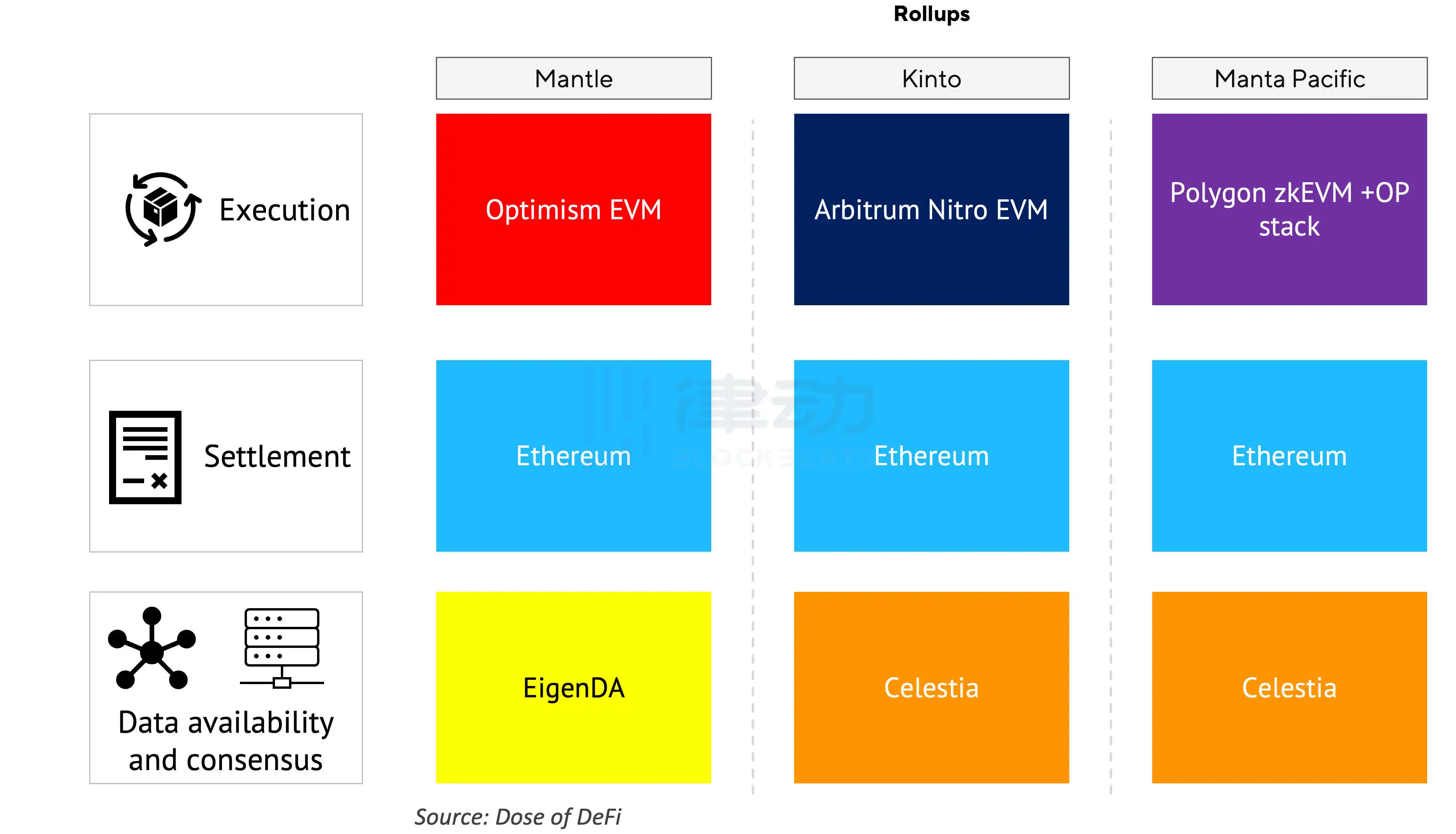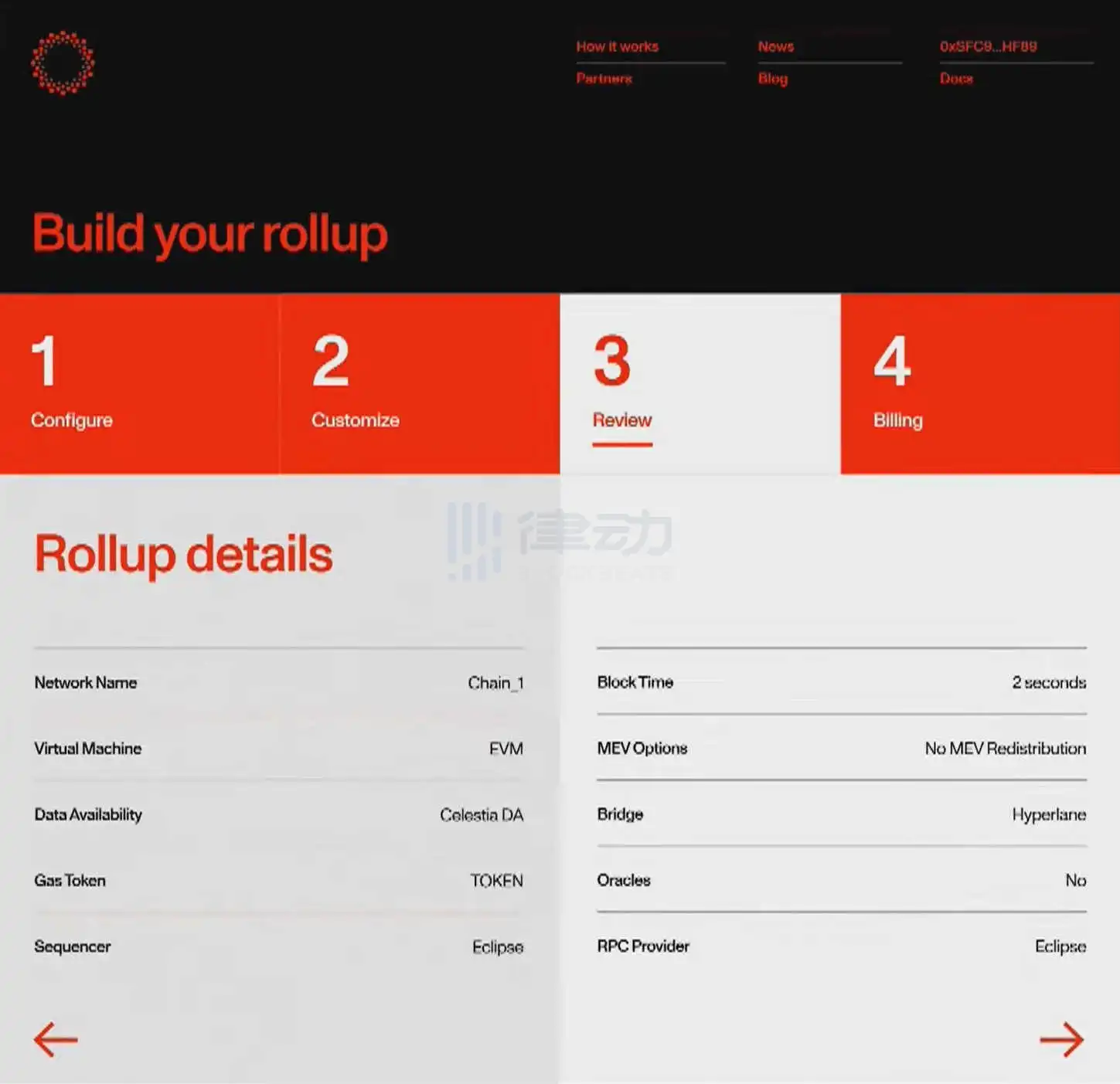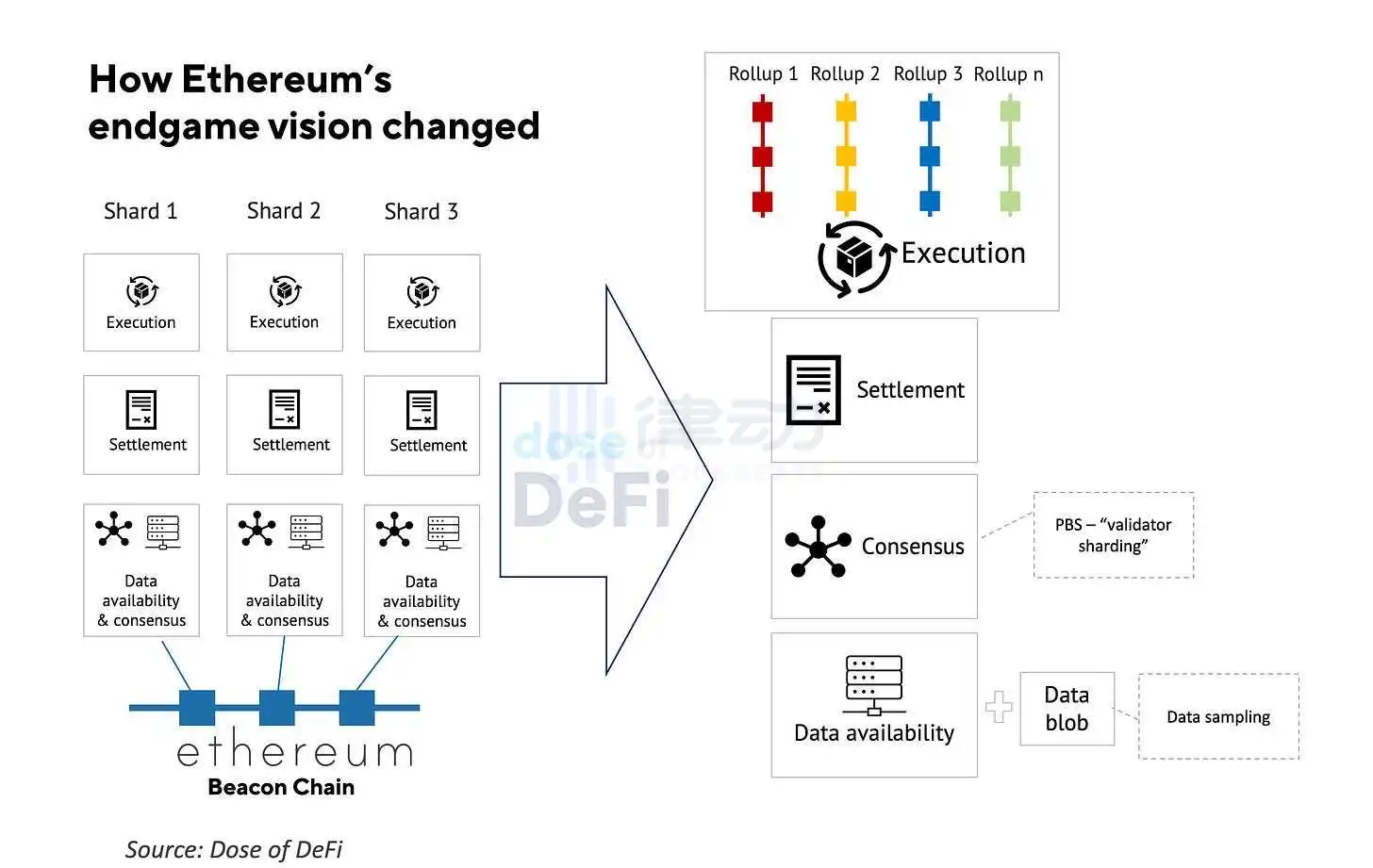An in-depth interpretation of the endgame between Ethereum and modularity
Compiled by: Ladyfinger, Blockbeats
Editor's note: With the continuous development of blockchain technology, two different design philosophies, single architecture and modular architecture, have demonstrated their respective advantages and application scenarios. Solana's single architecture provides a fast, low-cost transaction experience, but its high requirements for hardware may lead to a trend of centralization, while modular designs, such as the latest trends in Celestia and Ethereum, reduce costs by separating data availability layers. , improve security and flexibility, and support a wider range of applications and innovation.
These developments reflect the evolving nature of blockchain technology and the community’s continued exploration of the balance between security, decentralization, and scalability. With the further development of modular architecture, we may witness a richer and more diverse blockchain ecosystem, providing users and developers with more choices and possibilities. Although there are different opinions and approaches, these advances collectively push blockchain technology forward and mark its evolution towards a more mature and flexible architecture.
Single Era
Solana has been hugely popular lately, and for good reason. It has emerged from the dark days of the Alameda crisis with a strong run, going from frequent pauses to successfully handling the busiest airdrop claims in history while maintaining extremely low fees. Solana is a good choice from the perspective of attracting new users: Ethereum's L2 still charges a whopping $1 per transaction (we really don't think starting with BSC or Tron is a good idea).
Another advantage of Solana is its single global state that instantly reflects all market signals, with no jumps between rollups or shards for arbitrage and bridging. It's as if trading is seamless 24 hours a day on all trading platforms around the world, with events reflected instantly in price changes on all exchanges, regardless of geography or time zone. These are the benefits of a single chain at its best, but there are still drawbacks to this design choice. Most notably, the Solana validator set tends to be centralized due to very high hardware requirements. This is because Solana handles all three layers of blockchain in a single way: execution, consensus, and data availability.
On the other end of the design spectrum, there is a growing trend toward modular architecture, particularly outsourcing the data availability layer. The advent of this approach reduces transaction costs while keeping hardware requirements low (despite the threat MEV poses to this). Modular design also enables more specialized chains and hardware to be used for specific applications, dYdX is a good example of this. In modern design, the advantages of modular architecture are becoming increasingly prominent. It not only improves the flexibility and maintainability of the system, but also speeds up the development process and improves the overall performance of the system. By dividing the system into independent modules, each module can be developed, tested, and deployed independently, reducing development complexity and risk. In addition, modular design
At the forefront of the modular movement, Celestia is a chain focused on rollup data efficiency optimization. At the same time, Ethereum has gradually implemented modularity, building aircraft as it flies. We firmly believe that rollup technology is the key to achieving scale and reducing transaction fees, and the competition for the data availability layer (and other parts of the modular stack) has officially begun.
Scaling and Data Barriers
In the early race to scale the blockchain, data availability issues were initially identified. The focus was on minimizing the amount of stored data in order to maximize the number of nodes in the network. This dynamic also laid the foundation for Bitcoin’s block size war. Data availability refers to a blockchain’s ability to make its data accessible to all network participants. The key breakthrough was the introduction of Data Availability Sampling (DAS), as Bridget Harris explains.
"Through DAS, light nodes can confirm the availability of data by participating in random sampling rounds of block data without having to download every complete block. Once multiple rounds of sampling are completed and a certain level of confidence is reached threshold, confirms that the data is available, and the rest of the transaction process proceeds safely. In this way, a chain can expand its block size while maintaining easily verifiable data availability. Considerable cost savings are also achieved: these emerging layers can convert DA Cost reduction up to 99%."
Celestia, Avail, NearDA and EigenDA are the most important DA projects. They do not need to verify transactions, just check that each block is added via consensus and that new blocks are available to the network. They rely on third-party sequencers to execute and verify transactions. Celestia launches in October 2023, Avail and EigenDA will launch mainnet in the coming months, and Near recently announced its DA solution. Let’s review the unique features of each project:
1. Celestia chose the fastest path to market using fraud proof (which is also what Optimism rollups use). The trade-off is that Celestia will not be able to support ZK rollups in its current configuration. The Celestia team claims that 1., approximately 70% of all new Arbitrum Orbit chains are using Celestia for data availability.
2. Avail (formerly Polygon Avail), as an independent blockchain, provides a fast and secure data and consensus layer, giving developers what they need to start a rollup (either ZK Still optimistic).
3. EigenDA is probably the most consistent with Ethereum because it is a DA module, not a blockchain. Additionally, ETH restaking in EigenLayer will be available to secure rollups using EigenDA. Its weakness is that it does not use data sampling or data availability proof.
4. NearDA helps rollups save data availability fees by storing data on Near’s sharded blockchain. NearDA leverages an important part of the Near consensus mechanism, which parallelizes the network into multiple shards.
Massive Rollups Startup
Then let’s talk about the rollup itself. In rollups built on top of these Data Availability (DA) providers, there are a number of tools that make launching rollups easier:
1. By leveraging Celestia’s modular data availability, Manta Pacific provides the same Significant cost reduction compared to a monolithic L2 solution, and has already saved $1 million in Ethereum gas fees. Manta also uses custom opcodes to authenticate ZK technology, which makes it very cheap to implement privacy protection and native randomness into the protocol.
2. The Mantle network is built on a modular architecture that combines the optimistic rollup protocol with EigenDA’s data availability solution. This integration allows the Mantle network to inherit the security of Ethereum while also providing more economical and accessible data availability.
3. Kinto is a chain that requires KYC, and every user and developer on the network must complete the passport KYC process before making transactions. It uses Celestia to reduce costs.
In a truly modular way, the modules of each layer are selected according to specific needs. Here you can see the variety of combination options:

"Rollup As A Service" projects like Eclipse make it easier to start rollup and develop Authors can choose which technology to use for each module.
Similarly, Conduit allows users to deploy a rollup in 15 minutes. Supported technology stacks include Optimism, Arbitrum Orbit and Celestia. A monthly hosting infrastructure fee is paid to Conduit, and a separate data availability fee is payable to the provider.

#The richness of possible combinations created by modularity is undoubtedly a major advance. Is this similar to the difference between the difficulty of building a website in the early days compared to the ease and customization of using Squarespace today?
What this sentence means is that modular technology greatly simplifies the complexity of technology implementation by providing multiple combination possibilities, which is a major advancement in technology development. This advancement can be compared to the difference between the complex process of creating a website in the past and the convenient, highly customizable website building now using a platform like Squarespace. Modern platforms like Squarespace make it easy for people without a technical background to create and manage websites, and modular technology offers similar convenience and flexibility in blockchain and rollup implementations.
Trade-off Considerations
Despite the growth of data availability (DA) projects, many people have reservations about outsourcing DA. Vitalik made his point very clear: “Your data layer must be your security layer.” Dankrad Feist, another member of the Ethereum Foundation, agreed: “If it doesn’t use Ethereum for data availability, Then it is not an (Ethereum rollup) and therefore not an Ethereum L2."
We agree with this point of view. Rollups that outsource data availability will be less secure (and really should be called "validiums") than rollups that use the same chain for data and consensus, although safe enough for some applications. Short-term projects using this kind of rollup will appear and disappear quickly, making it a good experimental and testing ground. However, for long-term holding of financial assets, L1 like Ethereum or rollup for both data and consensus will remain the lowest risk networks.
Ethereum is moving towards modularity
While skeptical about outsourced data availability, Ethereum takes modular architecture very seriously. The original vision of scaling through sharding was abandoned in favor of modularity.

The three main updates needed to realize the vision are rollups (which we discussed earlier), proposer-builder separation ("Block proposers no longer generate a "Revenue maximization" blocks, instead delegating tasks to external actors (builders) in the market"), as well as data sampling. The latter is a way that allows light nodes to verify whether a block has been published by only downloading a small amount of randomly selected data. Technically, this is more challenging than the other two and will take two to three years to implement.
Important Note: EIP-4844 is the first step in improving the Ethereum data availability layer before data sampling goes live. As discussed before, improving Ethereum is akin to repairing an airplane while flying; once the Ethereum Foundation recognized the need for rollups (i.e. when Vitalik famously proposed a rollup-centric future), the team chose to do this by adding blobs (a Space specifically tailored for rollup data) to expand the block. Blobs are expected to reduce rollup transaction costs by a factor of ten. EIP-4844 is scheduled to go live in March/April in the Dencun upgrade. While this is a temporary solution to keep Ethereum competitive for two to three years, the long-term solution will be to support proof of validity on the mainnet itself, which will reduce the cost of rollups by orders of magnitude.
While Solana may be vehemently defending its monolithic architecture philosophy (and they may be right for many use cases), the industry appears to be moving toward modularity. As far as Ethereum is concerned, only a modular architecture can achieve the future:
1. Low transaction costs for millions of users (scalability) due to rollups;
2. The network is immune to Protection from threats such as censorship and 51% attacks (security);
3. An ordinary PC or even a mobile phone can run nodes to verify transactions (decentralization).
Someone may ask, does the modular architecture of Ethereum solve the blockchain trilemma that is considered to be unsolvable? Technically, it doesn't, since Ethereum is no longer a monolithic network, but as a modular network, it does.
Among the three, we believe that solving decentralization is the most important part of the trilemma. Innovation ultimately reduces transaction costs; prioritizing decentralization (especially geographical distribution) is the only way to ensure long-term network security. Ethereum leads the way in decentralization, with the most decentralized set of validators, with over 800,000 validators. At the same time, with a modular approach, it can adapt to new design innovations with custom rollups launched on top. Celestia and others certainly share this vision. The question that remains is whether Ethereum can move in this modular direction fast enough to keep up with competitors who are building from the ground up, rather than fixing the plane as they fly.
The above is the detailed content of An in-depth interpretation of the endgame between Ethereum and modularity. For more information, please follow other related articles on the PHP Chinese website!

Hot AI Tools

Undresser.AI Undress
AI-powered app for creating realistic nude photos

AI Clothes Remover
Online AI tool for removing clothes from photos.

Undress AI Tool
Undress images for free

Clothoff.io
AI clothes remover

AI Hentai Generator
Generate AI Hentai for free.

Hot Article

Hot Tools

Notepad++7.3.1
Easy-to-use and free code editor

SublimeText3 Chinese version
Chinese version, very easy to use

Zend Studio 13.0.1
Powerful PHP integrated development environment

Dreamweaver CS6
Visual web development tools

SublimeText3 Mac version
God-level code editing software (SublimeText3)

Hot Topics
 gate.io registration tutorial
Mar 31, 2025 pm 11:09 PM
gate.io registration tutorial
Mar 31, 2025 pm 11:09 PM
This article provides a detailed Gate.io registration tutorial, covering every step from accessing the official website to completing registration, including filling in registration information, verifying, reading user agreements, etc. The article also emphasizes security measures after successful registration, such as setting up secondary verification and completing real-name authentication, and gives tips from beginners to help users safely start their digital asset trading journey.
 What is Ouyi for? What is Ouyi
Apr 01, 2025 pm 03:18 PM
What is Ouyi for? What is Ouyi
Apr 01, 2025 pm 03:18 PM
OKX is a global digital asset trading platform. Its main functions include: 1. Buying and selling digital assets (spot trading), 2. Trading between digital assets, 3. Providing market conditions and data, 4. Providing diversified trading products (such as derivatives), 5. Providing asset value-added services, 6. Convenient asset management.
 gate.io latest registration tutorial for beginners
Mar 31, 2025 pm 11:12 PM
gate.io latest registration tutorial for beginners
Mar 31, 2025 pm 11:12 PM
This article provides newbies with detailed Gate.io registration tutorials, guiding them to gradually complete the registration process, including accessing the official website, filling in information, identity verification, etc., and emphasizes the security settings after registration. In addition, the article also mentioned other exchanges such as Binance, Ouyi and Sesame Open Door. It is recommended that novices choose the right platform according to their own needs, and remind readers that digital asset investment is risky and should invest rationally.
 What are the recommended websites for virtual currency app software?
Mar 31, 2025 pm 09:06 PM
What are the recommended websites for virtual currency app software?
Mar 31, 2025 pm 09:06 PM
This article recommends ten well-known virtual currency-related APP recommendation websites, including Binance Academy, OKX Learn, CoinGecko, CryptoSlate, CoinDesk, Investopedia, CoinMarketCap, Huobi University, Coinbase Learn and CryptoCompare. These websites not only provide information such as virtual currency market data, price trend analysis, etc., but also provide rich learning resources, including basic blockchain knowledge, trading strategies, and tutorials and reviews of various trading platform APPs, helping users better understand and make use of them
 How to roll positions in digital currency? What are the digital currency rolling platforms?
Mar 31, 2025 pm 07:36 PM
How to roll positions in digital currency? What are the digital currency rolling platforms?
Mar 31, 2025 pm 07:36 PM
Digital currency rolling positions is an investment strategy that uses lending to amplify trading leverage to increase returns. This article explains the digital currency rolling process in detail, including key steps such as selecting trading platforms that support rolling (such as Binance, OKEx, gate.io, Huobi, Bybit, etc.), opening a leverage account, setting a leverage multiple, borrowing funds for trading, and real-time monitoring of the market and adjusting positions or adding margin to avoid liquidation. However, rolling position trading is extremely risky, and investors need to operate with caution and formulate complete risk management strategies. To learn more about digital currency rolling tips, please continue reading.
 The latest registration tutorial for gate.io web version
Mar 31, 2025 pm 11:15 PM
The latest registration tutorial for gate.io web version
Mar 31, 2025 pm 11:15 PM
This article provides a detailed Gate.io web version latest registration tutorial to help users easily get started with digital asset trading. The tutorial covers every step from accessing the official website to completing registration, and emphasizes security settings after registration. The article also briefly introduces other trading platforms such as Binance, Ouyi and Sesame Open Door. It is recommended that users choose the right platform according to their own needs and pay attention to investment risks.
 okx virtual currency trading app apple download tutorial
Mar 31, 2025 pm 09:00 PM
okx virtual currency trading app apple download tutorial
Mar 31, 2025 pm 09:00 PM
This article provides tutorials on downloading and installing the OKX virtual currency trading APP Apple version. Due to Apple's system restrictions, it is recommended to directly access OKX official website to register. Android users need to allow the installation of applications from unknown sources in their mobile phone settings. After downloading the installation package, click Install, complete the installation process and start the APP, and finally register or log in to the account to start using OKX Exchange for virtual currency trading. The tutorial contains detailed steps to help you quickly get started with the OKX trading app.
 How to calculate the transaction fee of gate.io trading platform?
Mar 31, 2025 pm 09:15 PM
How to calculate the transaction fee of gate.io trading platform?
Mar 31, 2025 pm 09:15 PM
The handling fees of the Gate.io trading platform vary according to factors such as transaction type, transaction pair, and user VIP level. The default fee rate for spot trading is 0.15% (VIP0 level, Maker and Taker), but the VIP level will be adjusted based on the user's 30-day trading volume and GT position. The higher the level, the lower the fee rate will be. It supports GT platform coin deduction, and you can enjoy a minimum discount of 55% off. The default rate for contract transactions is Maker 0.02%, Taker 0.05% (VIP0 level), which is also affected by VIP level, and different contract types and leverages





